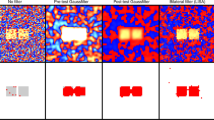Abstract
Parametric statistical analyses of BOLD fMRI data often assume that the data are normally distributed, the variance is independent of the mean, and the effects are additive. We evaluated the fulfilment of these conditions on BOLD fMRI data acquired at 4 T from the whole brain while 15 subjects fixated a spot, looked at a geometrical shape, and copied it using a joystick. We performed a detailed analysis of the data to assess (a) their frequency distribution (i.e. how close it was to a normal distribution), (b) the dependence of the standard deviation (SD) on the mean, and (c) the dependence of the response on the preceding baseline. The data showed a strong departure from normality (being skewed to the right and hyperkurtotic), a strong linear dependence of the SD on the mean, and a proportional response over the baseline. These results suggest the need for a logarithmic transformation. Indeed, the log transformation reduced the skewness and kurtosis of the distribution, stabilized the variance, and made the effect additive, i.e. independent of the baseline. We conclude that high-field BOLD fMRI data need to be log-transformed before parametric statistical analyses are applied.






Similar content being viewed by others
References
Boxerman JL, Bandettini PA, Kwong KK, Baker JR, Davis TL, Rosen BR, Weisskoff RM (1995) The intravascular contribution to fMRI signal change: Monte Carlo modeling and diffusion-weighted studies in vivo. Magn Reson Med 34:4–10
Chen C-C, Tyler CW, Baseler HA (2003) Statistical properties of BOLD magnetic resonance activity in the human brain. NeuroImage 20:1096–1109
Cox RW, Jesmanowicz A (1999) Real-time 3D image registration for functional MRI. Magn Reson Med 42:1014–1018
Duong TQ, Yacoub E, Adriany G, Hu X, Uğurbil K, Kim S-G (2003) Microvascular BOLD contribution at 4 and 7 T in the human brain: gradient-echo and spin-echo fMRI with suppression of blood effects. Magn Reson Med 49:1019–1027
Georgopoulos AP, Whang K, Georgopoulos MA, Tagaris GA, Amirikian B, Richter W, Kim S-G, Uğurbil K (2001) Functional magnetic resonance imaging of visual object construction and shape discrimination: relations among task, hemispheric lateralization, and gender. J Cogn Neurosci 13:72–89
Hanson SJ, Bly BM (2001) The distribution of BOLD susceptibility effects in the brain is non-Gaussian. Neuroreport 12:1971–1977
Hoogenraad FG, Pouwels PJ, Hofman MB, Reichenbach JR, Sprenger M, Haacke EM (2001) Quantitative differentiation between BOLD models in fMRI. Magn Reson Med 45:233–246
Hyde JS, Biswal BB, Jesmanowicz A (2001) High-resolution fMRI using multislice partial k-space GR-EPI with cubic voxels. Magn Reson Med 46:114–125
Kim S-G, Hendrich K, Hu X, Merkle H, Uğurbil K (1994) Potential pitfalls of functional MRI using conventional gradient-recalled echo techniques. NMR Biomed 7:69–74
Lai S, Hopkins AL, Haacke EM, Li D, Wasserman BA, Buckley P, Friedman L, Meltzer H, Hedera P, Friedland R (1993) Identification of vascular structures as a major source of signal contrast in high resolution 2D and 3D functional activation imaging of the motor cortex at 1.5T: preliminary results. Magn Reson Med 30:387–392
Lewis SM, Jerde TA, Tzagarakis C, Tsekos N, Amirikian B, Georgopoulos MA, Kim S-G, Uğurbil K, Georgopoulos AP (2002) Logarithmic transformation for BOLD fMRI data. Soc Neurosci Abstr 506.7
Lewis SM, Jerde TA, Tzagarakis C, Tsekos N, Amirikian B, Georgopoulos MA, Kim S-G, Uğurbil K, Georgopoulos AP (2003) Cerebellar activity during copying geometrical shapes. J Neurophysiol 90:3874–3887
Luo WL, Nichols TE (2003) Diagnosis and exploration of massively univariate neuroimaging models. Neuroimage 19:1014–32
Oja JM, Gillen J, Kauppinen RA, Kraut M, van Zijl PC (1999) Venous blood effects in spin-echo fMRI of human brain. Magn Reson Med 42:617–626
Pawlik G, Thiel A (1996) Transformations to normality and independence for parametric significance testing of data from multiple dependent volumes of interest. In: Myers R, Cunningham V, Bailey D, Jones T (eds) Quantification of brain function using PET. Academic Press, San Diego, Calif., pp 349–352
Pfeuffer J, Adriany G, Shmuel A, Yacoub E, Van De Moortele P-F, Hu X, Uğurbil K (2002) Perfusion-based high-resolution functional imaging in the human brain at 7 T. Magn Reson Med 47:903–911
Ruttimann UE, Rio D, Rawlings RR, Andreason P, Hommer DW (1998) PET analysis using a variance stabilizing transform. In: Carson RE, Daube-Witherspoon ME, Herscovitch P (eds) Quantitative functional brain imaging with positron emission tomography. Academic Press, San Diego, Calif., pp 217–222
Snedecor GW, Cochran WG (1989) Statistical methods. Iowa State University Press, Ames, Iowa
Song AW, Wong EC, Tan SG, Hyde JS (1996) Diffusion weighted fMRI at 1.5 T. Magn Reson Med 35:155–158
Tukey JW (1949) One degree of freedom for non-additivity. Biometrics 5:232–242
Uğurbil K, Hu X, Chen W, Zhu X-H, Kim S-G, Georgopoulos AP (1999) Functional mapping in the human brain using high magnetic fields. Philos Trans R Soc B 354:1195–1213
Uğurbil K, Adriany G, Andersen P, Chen W, Gruetter R, Hu X, Merkle H, Kim D-S, Kim S-G, Strupp J, Zhu X-H, Ogawa S (2000) Magnetic resonance studies of brain function and neurochemistry. Annu Rev Biomed Eng 2:633–660
Uğurbil K, Toth L, Kim D-S (2003) How accurate is magnetic resonance imaging of brain function? Trends Neurosci 26:108–114
Yacoub E, Vaughn T, Adriany G, Andersen P, Merkle H, Uğurbil K, Hu X (2000) Observation of the initial “dip” in fMRI signal in human visual cortex at 7 T. Proc Int Soc Magn Reson Med 8:991
Yacoub E, Duong TQ, Van de Moortele P-F, Lindquist M, Adriany G, Kim S-G, Uğurbil K, Hu X (2003) Spin echo fMRI in humans using high spatial resolutions and high magnetic fields. Magn Reson Med 49:655–664
Acknowledgements
This work was supported by United States Public Health Service grant NS32919 and P41 RR08079 (National Center for Research Resource (NCRR), the University of Minnesota Graduate School (T.A.J.), the United States Department of Veterans Affairs, and the American Legion Chair in Brain Sciences.
Author information
Authors and Affiliations
Corresponding author
Rights and permissions
About this article
Cite this article
Lewis, S.M., Jerde, T.A., Tzagarakis, C. et al. Logarithmic transformation for high-field BOLD fMRI data. Exp Brain Res 165, 447–453 (2005). https://doi.org/10.1007/s00221-005-2336-4
Received:
Accepted:
Published:
Issue Date:
DOI: https://doi.org/10.1007/s00221-005-2336-4




